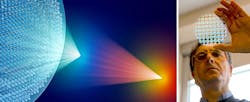Metasurface lenses infiltrated with liquid crystal are reconfigurable
In the last decade or so, a group led by scientist Federico Capasso at Harvard University's John A. Paulson School of Engineering and Applied Sciences (SEAS; Cambridge, MA) has begun to transform the field of optics by engineering flat optical metasurfaces that use an array of millions of microscopically thin and transparent fused-silica pillars to control phase, amplitude, and/or polarization of light.
The technology was selected as among the Top 10 Emerging Technologies by the World Economic Forum (WEF) in 2019, which remarked that such lenses would soon begin to be seen in smartphone cameras, sensors, fiber-optic components, and medical-imaging devices such as endoscopes.
Now, Case Western Reserve University (Cleveland, OH) physics professor Giuseppe Strangi and collaborators at Harvard have taken a step toward making these metasurface lenses even more useful, by making them reconfigurable.1 They did this by harnessing nanoscale forces to infiltrate liquid crystals between the fused-silica pillars.
They infiltrated three different sorts of liquid crystals of different refractive index and birefringence, then evaluated the metalens performance; the experimental results agree qualitatively with finite-difference time-domain solver (FDTD) simulation results. By electrically controlling the liquid crystal, the researchers will enable this new class of metalenses to reconfigure and structure light.
Commercial interest already
“This is just the first step, but there are many possibilities for using these lenses, and we have already been contacted by companies interested in this technology,” says Strangi.
Strangi collaborated with several other researchers in the United States and Europe, including fellow Case Western Reserve researchers Andrew Lininger and Jonathan Boyd; Giovanna Palermo of Universita’ della Calabria in Italy; and Capasso, Alexander Zhu and Joon-Suh Park of the John A. Paulson School of Engineering and Applied Sciences at Harvard University.
Capasso, who pioneered the metasurface optics research field and in 2014 first published research on metalenses, credited Strangi for the idea to infiltrate the metalenses with liquid crystals and says this innovation represents a step toward more-significant advances.
“Our ability to reproducibly infiltrate, with liquid crystals, state-of-the art metalenses made of over 150 million nanoscale diameter glass pillars and to significantly change their focusing properties is a portent of the exciting science and technology I expect to come out of reconfigurable flat optics in the future,” Capasso notes.
Source: https://thedaily.case.edu/a-new-lens-on-the-world/
REFERENCE:
1. Andrew Lininger et al., Proceedings of the National Academy of Sciences (2020); https://doi.org/10.1073/pnas.2006336117
About the Author
John Wallace
Senior Technical Editor (1998-2022)
John Wallace was with Laser Focus World for nearly 25 years, retiring in late June 2022. He obtained a bachelor's degree in mechanical engineering and physics at Rutgers University and a master's in optical engineering at the University of Rochester. Before becoming an editor, John worked as an engineer at RCA, Exxon, Eastman Kodak, and GCA Corporation.

